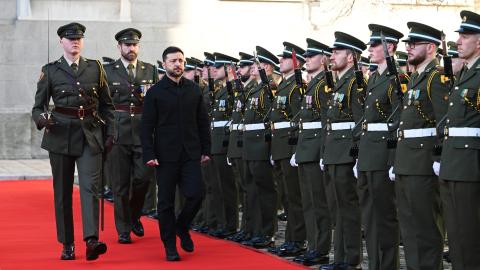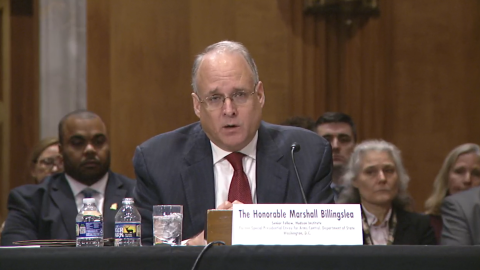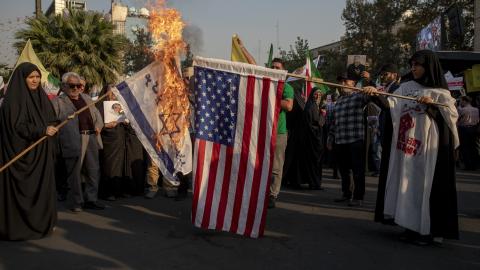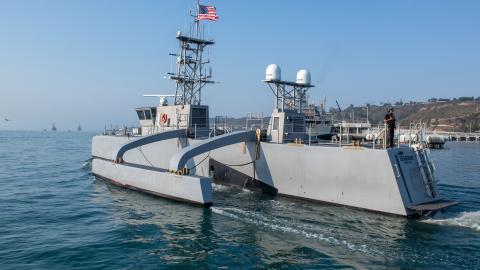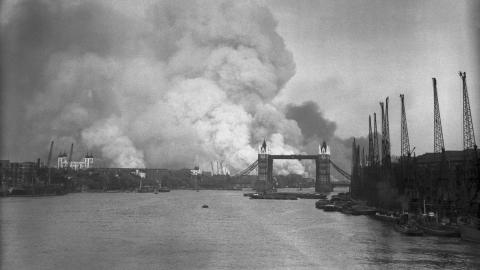For students of military affairs, the past is an imperfect guide. The best one can do is to try to understand how events played out in their moment and which of their aspects reoccur today. One of the most pressing, and worrying, questions on the table is whether our moment most resembles 1939 or 1979. In the first, a major war had engulfed one end of Eurasia, and the other end stood on the precipice of mass death, misery, and terror. In the second, the free world was on the defensive, at risk of being overwhelmed by the forces of tyranny, until a series of seemingly miraculous events and the rise of dogged and inspiring leaders across the West turned the tide before the worst transpired.
The global situation is once again veering toward catastrophe. Europe suffers from its largest war since World War II, the Middle East is in the midst of a long and bloody conflict, and Red China is relentlessly arming for war. The free world’s leaders responded ineptly to the challenges of the 1930s, and millions paid with their lives. Forty years later, they woke up just in time. Those in power today should do everything they can to prepare for, and thereby stave off, the worst.
The American arms industry has exquisitely prepared for a different threat from the one this country faces. The Pentagon honed its forces to combat America’s enemies at minimal risk to American and allied personnel, and it has succeeded splendidly. As Israel demonstrated in the skies above Iran, the F-35 stealth fighter can defeat some of the most advanced air defenses on the planet. The American strikes on Iranian nuclear facilities revealed the awesome power of even older American equipment, such as the B-2 bomber. And American air defenses have proved their mettle across Eastern Europe and the Middle East.
But that might not be enough if Xi Jinping starts a war. Some publicly available estimates warn that American forces would run out of long-range missiles within days or weeks of combat. Admiral Samuel Paparo, the Indo-Pacific commander, said in May, “The United States will prevail in the conflict as it stands now, with the force that we have right now,” but “really every force element that is salient is [on] a bad trajectory.”
Much of the forecasting about a conflict with China — over Taiwan, for example — focuses on the efforts to repulse the initial Chinese attack. This is important but insufficient. As many of the combatants discovered during World War II, few large countries succumb to the first blow, and most theories of how to attain quick victory fail.
Both Axis powers mistakenly believed that they could achieve their goals through lightning blows. They failed, and as the resulting conflicts deepened and widened, their leaders had to throw their forces into the maw of wars that they desperately sought to close.
Japanese defense planners observed the carnage in Europe during the First World War with alarm. They preferred the short, decisive wars that allowed them to wrest Taiwan from China in 1895 and parts of the Asian mainland from Russia a decade later, but they feared that their small, resource-poor nation would have to fight a prolonged, total war like the one unfolding in Europe. An initially small but determined cabal focused obsessively on acquiring Manchuria and then expanding and exploiting the empire.
Their plans to prepare for total war required a few more quick victories. The seizure of Manchuria in 1931 was a success, but it sparked a seething resentment across China that Tokyo could not placate. In 1937, the Japanese army decided to end the dispute. It sent three divisions to seize Beijing and its surrounding area and then expected Nationalist leader Chiang Kai-shek to sue for peace. It forecast that the operation would last three months and cost the treasury about 100 million yen.
Instead, Tokyo brought on exactly the kind of grinding, interminable conflict for which its leaders knew they were unprepared. Beijing fell, but Chiang did not give up. By early 1938, Japan realized it had to raise another 20 divisions, and the annual budget ballooned from 2.77 billion yen to 8.36 billion. Even this was not enough: Japanese forces took most of China’s coastline and conquered Chiang’s capital, Nanjing, butchering and abusing the civilians there, but still China did not fall.
The war in China escaped any rational policy aim for Japan, other than the necessity to avoid losing to an overmatched opponent. Japanese industrial planners soon realized that their country would still be utterly dependent on its American and British rivals for resources even if it fully integrated China’s economy. Oil was a particularly acute problem, and Japan’s campaign to acquire it by seizing European colonies in Southeast Asia triggered an American embargo that nearly crippled the Japanese war machine.
Tokyo got itself into a quagmire by underestimating Chinese will, and it doomed itself by getting the Americans wrong too. Its navy inflicted a heavy blow during the sneak attack on Pearl Harbor in 1941 and then unsuccessfully sought to destroy American naval forces in a climactic, Mahanian victory. As Japan’s navy tied down American and British forces, its army conquered much of Southeast Asia and the region’s resource base, giving Tokyo needed materials. It also conquered and fortified islands across the Pacific, where it planned to endure the American counterattack and wait for Washington to sue for peace.
Adolf Hitler also realized that Germany’s prospects in a long war were grim, so he sought to gain lebensraum on the cheap. His 1939 invasion of Poland, with the aid of his Communist ally, Joseph Stalin, took five weeks. Even so, the Germans lost a quarter of the tanks sent into the field against the outnumbered but determined Poles.
As in Asia, this initial victory set the stage for a long, grinding war. Britain and France declared war on Germany, although their passivity during the sitzkrieg, or “Phony War,” gave Hitler time to prepare for an all-out push in 1940. His blitzkrieg defeated France in six weeks — barely longer than the much smaller Poland had held out against much longer odds.
But Hitler’s luck turned after the French surrendered. His aerial blitz failed to cow Britain, which under Winston Churchill rallied to defend what remained of free Europe, despite Germany’s massive investments in the Luftwaffe. A panicked Congress nearly doubled the U.S. Navy’s tonnage and instituted the first peacetime draft in American history. Equally alarming and more immediately troubling for Hitler, the first Lend-Lease Act, in 1941, sent Britain the monetary equivalent of two years of German arms production. That year, Britain received 5,012 aircraft from the United States, while Germany got 78 planes from occupied France and the Netherlands.
Hitler’s next attempt to improve Germany’s strategic position worsened it. Shortly after defeating France, he began planning to attack his Soviet allies and seize their economic resources before turning westward again to face off against Britain and the United States. Over the next eight months, the Wehrmacht doubled its tank divisions from ten to 20. In June 1941, over 3 million men invaded the Soviet Union. They inflicted horrendous losses on the Soviet military but failed to destroy it as planned. The Nazis feared attritional and two-front wars but doomed themselves to both. Their increasingly desperate searches for wonder weapons produced some technologically impressive machines but did nothing to turn the tide.
The Americans approached the war entirely differently and therefore fared much better. Their arms industry started ramping up in 1938 to sell to Britain and France and kicked into a higher gear starting in 1940. Even so, American defense planners knew that the war would last for years and prepared accordingly. By 1942, the United States was outproducing all the Axis powers combined and kept extending the lead throughout the conflict. As my colleague Arthur Herman points out in Freedom’s Forge (and whose piece leads this section), some of the most important contributors to the war effort, such as Henry Kaiser, had no experience operating a factory before the war began.
Hitler’s defeat proceeded in stages, each of which was long and costly. Initially, Washington hoped to land in France in early 1943 — nearly a year and a half after Pearl Harbor — but that plan quickly grew infeasible. German submarines menaced the Atlantic, and the buildup for Europe’s liberation could only seriously commence after those U-boats were suppressed. The Battle for the Atlantic reached its zenith in 1943, but the fighting continued until the Nazis surrendered.
In the meantime, Americans found other ways to strike Germany. American and British heavy bombers attacked industrial and military installations across the German empire. The cost was ghastly: for a time, the statistical likelihood of an American bomber crew surviving its tour was zero percent. American ground forces gained experience in amphibious operations by fighting their way across North Africa and up the Italian peninsula. Each landing delayed the liberation of northern Europe, but by June 1944, the Allies were ready. The final offensive took nearly a year.
Pearl Harbor was a surprise, but the U.S. Navy had begun preparing for a Pacific war decades before. President Theodore Roosevelt requested those plans, and defense officials sharpened War Plan Orange over the next several decades. They assumed that the war would be long and bloody: for example, the 1928 version anticipated that it would take 690 days for the Americans to gain control of the seas around Japan.
Even that timetable was wildly optimistic. After Pearl Harbor, the American counteroffensive did not begin in earnest until well into 1943. The island-hopping campaign skipped many Japanese-held islands, but the defenders sold their lives dearly and fought nearly to the last man. As the Americans neared the Japanese home islands, the enemy’s ferocity increased: kamikaze attacks slammed into American ships, and on Okinawa, Japanese civilians charged American troops with bamboo spears and other makeshift weapons.
Invading Japan was a daunting task, but the fruits of America’s strategy for protracted war fully emerged in the summer of 1945. In 1940, Franklin D. Roosevelt announced to widespread disbelief that the United States would produce 50,000 planes annually. At its peak, the United States churned out 95,000 in one year. After years of troubled development, B-29 heavy bombers, the most expensive American weapons system of the war, filled the skies above Japan and systematically destroyed nearly every Japanese city with incendiary bombs. But not all of them: Hiroshima and Nagasaki were obliterated by one B-29 apiece, each carrying the ultimate wonder weapon, the atomic bomb.
Warfare in many aspects changed overnight. As other industrialized powers nuclearized, the preponderance of American nuclear forces seemed to make protracted war between those powers a thing of the past. The problem reappeared just as the Soviet Union began to dissolve under the weight of its internal contradictions. But as the Four Horsemen of the Apocalypse polish their riding boots, the question of protracted war has assumed a new urgency.
Until the Soviet nuclear arsenal achieved rough parity with the American one in the late 1970s, industrialized warfare seemed an anachronism. Many thought a Soviet conventional offensive would elicit a nuclear American response that would, one way or another, lead to the war’s early termination. But by 1977, Secretary of Defense Donald Rumsfeld warned that “the main burden of deterrence has once again fallen on the conventional forces.” The Carter administration tentatively rebuilt American conventional forces, which had collapsed into a “hollow force” after Vietnam, and Ronald Reagan significantly boosted the rearmament campaign. For the last dozen years of the Cold War, defense planners studied the implications of nuclear stalemate and developed options to respond, but the Soviets imploded before Washington landed on a solution.
The current wars in Ukraine and the Middle East warn against heeding the siren song of quick victory, the one that lured the Axis to its doom. Vladimir Putin’s lightning offensive in February 2022 failed early, and the ensuing war has cost 250,000 Russian lives and an additional 700,000 casualties. Maxim Reshetnikov, Russia’s minister of economic development, observed that, despite the military spending boom, “we’re basically already on the brink of falling into a recession.”
In June, Israel’s so-called twelve-day war looked like a swift victory over Iran, but it is really one campaign in a war that Iran and its proxies started on October 7, 2023. That war is still ongoing. Nuclear weapons have deterred certain kinds of attacks in both conflicts, but they have not rendered conventional defenses obsolete.
In 1936, Churchill informed the House of Commons about his experience in the First World War: “Here is the history of munitions production: first year, very little; second year, not much, but something; third year, almost all you want; fourth year, more than you need.”
It has been more than three years since the Russians reopened their war against Ukraine, and nearly two since Iran did the same against Israel. America’s allies and partners are paying in blood for American unpreparedness. If we do not deter China, it will be our turn next.




